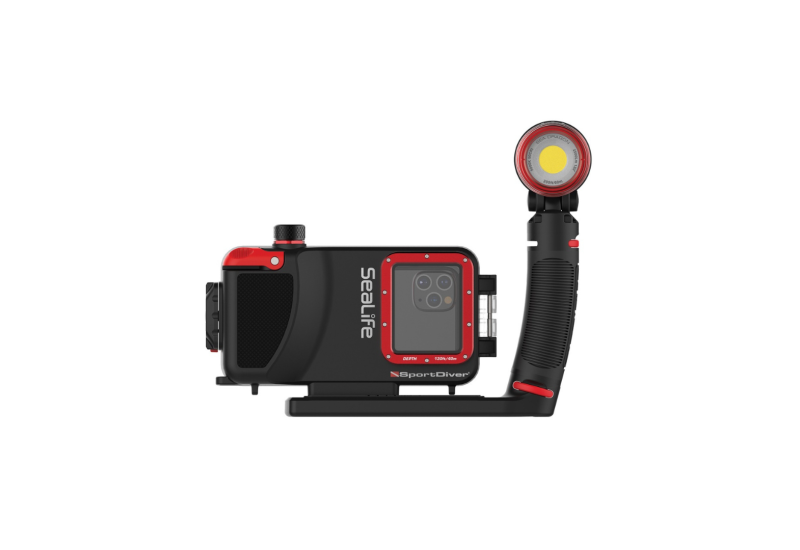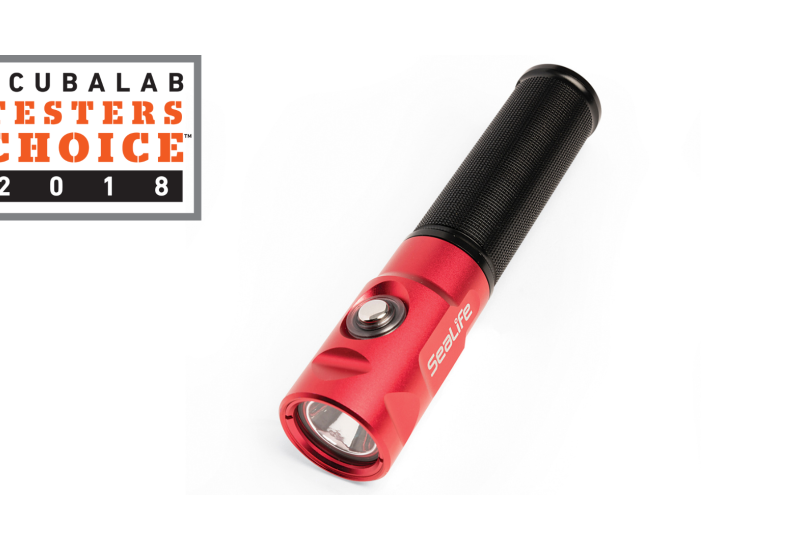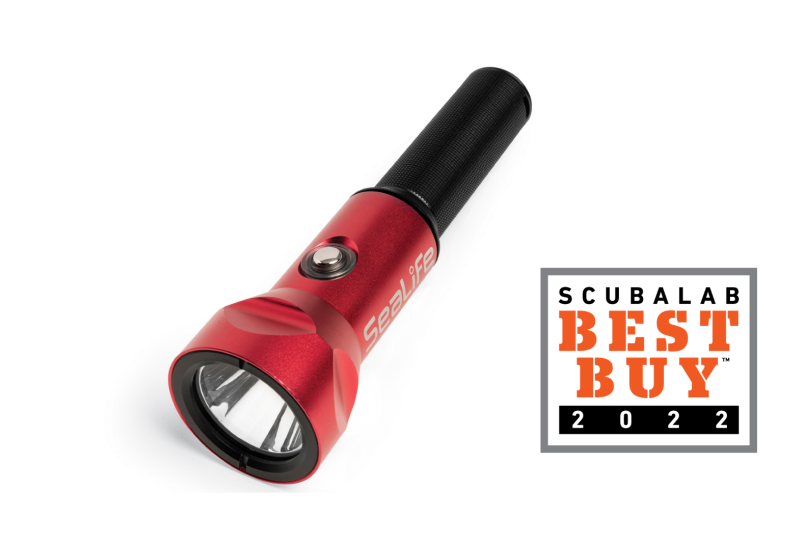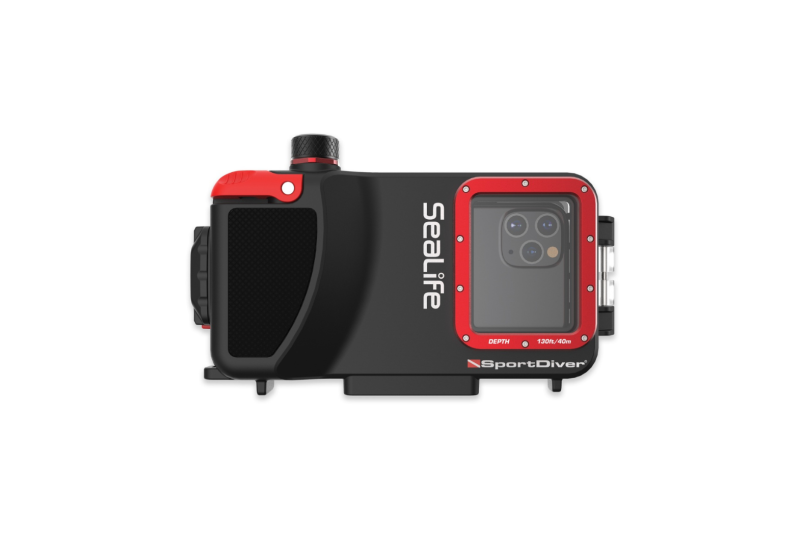6 New Diving Knives
By Bill Kendig
Photography by Joseph Byrd
 |
 |
We know what you're thinking: A sexy-looking dive knife is the perfect accessory to complete your underwater ensemble. But we were more interested in seeing how they performed on typical underwater cutting tasks. We turned these six knives loose on an assortment of materials commonly found in a marine environment, from fishing monofilament to three-strand anchor line to high-tech cable-strength braids. Since five of the six knives are full-sized, high-end cutters, it was no surprise that they were able to cut their way through our line inventory. What was surprising, given our experience with knife tests of the past, was how easily most of them did it. (See the individual reviews as well as "The Cutting Test".)
For this year's knife review, we tracked down six new models with designs or features that make them better-suited for particular styles of diving. All are serious cutting tools designed to saw and slice through diving's most serious cutting challenges. All of them are smaller than the massive dive knives of old, plus they're a lot more efficient at cutting and a lot easier to use, mount and maintain.
We also subjected them to our "rust test," an extended period of wet neglect in a saltwater environment to see how well they resist rust and corrosion. Each knife was soaked in saltwater three times a day for a week. Between soaks we set the knives out to dry while still in their sheaths. At the end of the cycle, knives and sheaths were inspected. In general, the titanium and more exotic stainless blades were the most resistant to corrosion, while the softer 304-grade stainless knives showed less signs of rust than the harder 420-grade stainless knives. No rust spots were so imbedded that they couldn't be buffed out with a towel. The lesson: A bit of maintenance will keep a modern dive knife looking new for virtually its entire operating life. (More rust test results can be found in individual reviews.)
Riffe Silencer
 |
Overall length: 9 in.
Blade length: 4.5 in.
Blade type: Plain edge and serrated edge.
Material: 420 stainless steel.
Price: $90.
Features The Silencer is made of hardened (heat-treated) 420 stainless steel and has cutting edges sharp enough to cut virtually anything. The 4.5-inch stiletto blade, which is Teflon-coated to prevent rusting, offers a plain edge on one side and a wavy serrated edge on the other, giving you a choice of cutting surfaces. The over-molded handle has an ample blade guard for a safe and secure grip. It also offers a tool built into the end-cap to remove spear shafts that get wedged in rocks. The sheath comes with a pair of rubber leg straps and offers a locking push-button release. An elastic lanyard attaches to the end-cap for extra security.
Performance The Silencer's blade, with three inches of serrated edge and four inches of plain edge, proved to be the best all-around cutter in this review. It was the only knife able to slice through every type of test line--even the Amsteel--with a single pull, and it did it with both edges. For spearfishermen who can get wrapped in their own line during a hunt, this is the Silencer's strongest selling point. But the sharp stiletto point is a winner too, designed to quickly dispatch a struggling fish. While the blade is Teflon-coated to prevent rusting, the cutting edges aren't, so by the end of our corrosion test, the Silencer was showing a couple spots of rust; however, they all rubbed out with a towel. The Silencer's sheath is one of the best we've seen. A sliding safety mechanism prevents an accidental push of the push-button release. The safety and release button are both easy to operate one-handed, and the elastic lanyard can be stretched over the sheath for added security. Standard rubber leg straps have quick-release buckles and can be replaced with optional forearm stretch-straps for a closer reach.
Bottom Line A speared fish isn't always a dead fish, and the line you're caught in might be your own. For this, the Silencer is a must-have cutting tool. However, take care returning this sharp-point knife to its sheath, and a post-dive rinse is always recommended.
Best For Spearfishermen, dispatching fish or escaping a tangle of speargun line. Able to cut just about anything.
Scubapro White Tip
 |
Overall length: 6 in.
Blade length: 2.5 in.
Blade type: Plain edge and serrated edge.
Material: 304 stainless steel.
Price: $58.
Features A backup cutter should be compact, and the White Tip is certainly that. Only six inches long overall, it comes with a 2.5-inch blade offering an inch of serrated edge, an inch of plain edge, and an angled tanto tip that's nicely blunted right at the end. The blade and handle are made from a single length of 304-grade hard-tempered stainless-steel--the handle portion is over-molded to provide an easy grip. The sheath offers a push-button release that keeps the knife secure until needed. The White Tip comes in a kit complete with hardware to mount on a console hose or BC pocket (this requires punching holes in the material). The sheath also has slots for threading a pair of rubber straps for mounting on an arm or leg. For added security, there's a hole in the handle for a lanyard.
Performance The White Tip offers more mounting options than any other knife in this review, making life easy when deciding where to strap it. Removing the knife from its sheath is also easy--the push-button release can be activated with one hand. The partially blunted tanto tip takes some of the apprehension out of returning the knife to its sheath, and a solid-sounding click lets you know the knife is locked in place. Because of its 304 stainless blade, which doesn't hold an edge as well as harder metals, and its short blade length that offers less cut per pull, the White Tip was not the most efficient cutter of the group. However, it was able to eventually cut through our entire inventory of test lines, taking only a couple pulls to get through the lighter lines, 10 to 18 pulls on the heavier lines, and 25 pulls on the Amsteel. It did a good job of resisting rust; after a week of repeated saltwater dunks it showed no signs of tarnishing.
Bottom Line It always makes sense to carry a backup cutting tool, especially one that's compact and doesn't clutter up a dive rig. We like the White Tip's ability to bolt to a hose, a strap or a BC. But if none of these options suits you, the White Tip is so small it will probably fit into your BC pocket.
Best For Just about anybody as a compact, BC-mounted backup cutter.
Spyderco Aqua Salt
 |
Overall length: 9.25 in.
Blade length: 4.5 in.
Blade type: All plain edge or all serrated edge.
Material: H-1 stainless steel.
Price: $164.95.
Features This knife is not to be trifled with. Its blade has a lethal point and comes with either a scalpel-sharp plain edge or a seriously serrated SpyderEdge (a pattern of one large and two small serrations) backed by a full-curve "belly" that produces very effective slicing-type cuts. The blade is made of rust-free H-1 stainless, a special composite exclusive to Spyderco that uses nitrogen in place of carbon in its steel matrix. This maximizes corrosion resistance while still enabling the blade to hold a sharp edge. The handle is made of textured, fiberglass-reinforced nylon. The heavy-duty Kydex sheath is riveted for strength. It secures the knife with a friction lock and features a G-Clip belt fastener that can be configured in five positions to suit your diving style. The Aqua Salt is available with either a yellow or black handle with a hole for a lanyard.
Performance Both plain edge and SpyderEdge versions of the Aqua Salt were able to cut through our inventory of line, though the serrated version had an easier time doing it. The full-sized handle let us grip and rip; while there's not much of a blade guard, the textured handle and finger grooves keep hands from slipping forward. We cut all test line with a single pull except for the Amsteel, which took five pulls. The H-1 blade excelled in the rust test, showing no signs of corrosion on the blade and only a slight bit of tarnish on the engraved "H1" logo, which rubbed right off. The G-Clip belt fastener fits securely on a standard two-inch harness strap, and the sheath's grommet holes offer cable-tie attachment points for added security. One-handed removal is accomplished by pressing your thumb against the top of the sheath. The large mouth makes an easy target when returning the blade home, which clicks when the friction lock activates.
Bottom Line If you've always had a hankering to take your sharpest chef's knife diving with you, leave it in the drawer and take this one instead. Of the two styles, we prefer the serrated version for its better cutting efficiency. But neither style disappoints. A bit of advice: Mount the sheath where you can see it; a near-miss when returning the blade home can get bloody.
Best For Working divers faced with heavy-duty cutting of all kinds.
Spyderco Mariner Salt
 |
Overall length: 8.5 in.
Blade length: 3.75 in.
Blade type: Serrated edge.
Material: H-1 stainless steel.
Price: $209.95.
Features This all-stainless-steel folding knife is built specifically for saltwater environments, but can be used virtually anywhere. Like the Aqua Salt, the Mariner Salt's SpyderEdge blade is made of H-1 stainless, a special composite that substitutes nitrogen for carbon in its steel matrix. As a cutting tool, it offers a nice, simple design. A very usable sheepfoot-style serrated blade folds into a heavy-duty handle fitted with a shackle key, belt clip and lanyard hole, and that's it. Folded, the knife measures a compact 4.75 inches; open, 8.25 inches. The sheepfoot blade has a rounded tip for avoiding accidental pokes and punctures.
Performance The upside to this knife is its compact size when folded, and its full-size blade for cutting. Opening and closing the blade is a one-handed affair, thanks to Spyderco's Round Hole design. Just press your thumb into the hole in the blade and rotate it open. To close, press the indent on the back of the handle to unlock the blade and fold it closed. When it comes to cutting, the Mariner Salt knows its business. It sliced through all our test lines like proverbial butter--except for the Amsteel line, which required six pulls to get through. This was primarily because the sharpened points of the SpyderEdge serrations started to snag when the Amsteel became a tangle of frayed threads. Jimping, or texturing, on top of the blade improves thumb traction and makes it easier to apply cutting pressure. When it comes to maintaining this knife, fuhgeddaboutit. After a week of repeated dunkings in saltwater without a rinse, the Mariner Salt looked as good as new.
Bottom Line No doubt, this is the ultimate folding knife for a saltwater environment. Tip: Although it has a nice stainless belt clip, we found the best place to carry this knife when diving was in a BC pocket or small pouch fixed to a harness. And we'd also recommend attaching a lanyard. This cutter costs too much to lose.
Best For Traveling divers, and for all-purpose topside cutting. It's a full-size knife you can stow in your back pocket or BC pocket.
XS Scuba Beta Titanium
 |
Overall length: 10 in.
Blade length: 5 in.
Blade type: 1/2 plain edge, 1/2 serrated edge.
Material: Titanium.
Price: $110.
Features By today's standards, the 10-inch-long Beta Titanium can be considered a full-size dive knife, and it's a far sight better than the bruisers of the past. The Beta's blade is lighter, stronger and sharper than those of the Sea Hunt generation, and it's titanium, so it will never rust. The knife comes with a nice-sized Sure-Grip handle with moderate-sized blade guards, a stainless-steel end-cap for hammering, a combination plain/serrated cutting edge, a line-cutting notch, and your choice of a point, blunt or tanto tip. The sheath has a locking tab and a backup safety slide. Rubber straps with quick-release buckles are provided for attaching the knife to your leg.
Performance You can't beat titanium when it comes to rust resistance. At the end of our week-long saltwater dip tests, our Beta knife looked like it had just slipped out of its display box. XS Scuba sent us the tanto-tip version that offers a combination of plain and serrated edges on the main portion of the blade, plus a stretch of plain edge on the tanto tip. However, we found the serrated section to be the most effective cutting surface. The shallow serrations cut through all types of test line, including the Amsteel, with only one or two pulls. The Beta's handle fits very comfortably in the hand, with rubber over-molding and lower finger grooves for maintaining a secure grip. The sheath is first-rate and easy to access one-handed. Slide one finger under the primary release tab and the knife slips out. The knife reinserts with a distinct clicking sound. The backup safety slides over the blade guard to prevent dropouts, making this the one of the most secure sheath systems in this review.
Bottom Line This is a sizeable knife, reminiscent of old-school-styles, but much, much better. With the hammer end-cap, line-cutting notch and variety of cutting edges, the Beta Titanium is a true multipurpose tool. Get the blunt-tip version and you can do some light prying too.
Best For General-purpose cutting (all versions) and light prying (blunt tip only). This is a modern version of the traditional dive knife.
XS Scuba FogCutter Delta
 |
Overall length: 10.25 in.
Blade length: 4.5 in.
Blade type: Plain edge, serrated edge and shears.
Material: 420 stainless steel.
Price: $80.
Features The Delta is the largest cutter in this review and the most unique. It's the third generation in a line of FogCutter multipurpose knife/shears combo tools, and by far the best. The scissor blade is shorter than previous versions and located on the bottom side of the main blade. This greatly improves the scissor function while maximizing the knife's cutting surfaces, which include three inches of plain edge, close to two inches of serration on the lower edge of the scissor blade, and a 2.5-inch stretch of serration on the top edge of the main blade. The knife is made of 420-grade stainless steel to hold a sharp edge, and is treated with chromate to prevent rusting. A new co-molded handle with finger grooves provides a solid grip. It has an end-cap for pounding hard surfaces and will accommodate a lanyard. The sheath also has finger grooves, plus a knife lock with push-button release.
Performance The FogCutter Delta is a versatile tool offering all kinds of cutting choices. The shears worked better than most of the knives when cutting the thinner test lines. They bogged down on the 1/2-inch nylon and Amsteel, so that's when we switched to the knife blade. With serrated edges on top and bottom you can either press down or pull up when cutting through the thicker and tougher lines--it took only three pulls for the heavy 1/2-inch anchor line, two pulls for the Amsteel, and a single pull for everything else. The 420 stainless provides a nice hard edge, but after a week of saltwater soaks, it showed signs of corrosion where the blade contacts the sheath. However, we were able to scrub it all off with a towel. A nice surprise was that the hardware that holds the shears blades together showed no rust. As the longest knife in the group, the Delta fits best on the calf. The leg straps have quick-release buckles for easy donning and doffing, and the large release button on the sheath allows for one-handed removal.
Bottom Line The FogCutter Delta appeals to the MacGyver in all of us. It's a much more efficient cutter and easier to use than its predecessors. If you're a wreck diver who normally carries shears as a backup, the FogCutter Delta will make your day.
Best For Wreck divers who need good cutting blades plus some backup shears.
Zeagle Line Cutter
 |
Overall length: 5 in.
Blade length: 1.75 in.
Blade type: Serrated edge and plain edge.
Material: Stainless steel.
Price: $19.99.
Features While not a dive knife, a line cutter can be an excellent cutting tool. Zeagle's line cutter is a perfect foil for anything from monofilament line to moderate-sized cord. It's compact, measuring only five inches overall, and features a large serrated edge with a variety of tooth sizes, and a handy yellow handle with room for a couple gloved fingers to grab hold. The friction lock sheath has a two-inch belt clip for quick mounting on most straps, or it can be cable tied almost anywhere on your dive rig.
Performance We were surprised that this line cutter was able to make it through every one of our test lines. Even the Amsteel parted after only six pulls. Not bad considering the cutter has such a short blade. Its compact size makes it a nice backup cutter to a traditional knife. The belt clip fits horizontally or vertically on shoulder and waist straps. However, the friction lock is minimal, so make sure to push the cutter into the sheath all the way before heading out on your dive. After a week without a rinse only a few spots of rust showed up and were easily scrubbed off with a towel.
Bottom Line Small, sharp and inexpensive, this is a practical tool for loop-type cutting and a great backup to a larger, more traditional primary dive knife.
Best For Cave divers, as a backup cutter for small line cutting.
Anatomy of a Dive Knife
What to look for in an underwater cutter.
Blade Material Stainless steel is the standard alloy for dive knives. Two particular grades get most of the business. Traditional 304-grade stainless is relatively soft as far as metals go. As a result, it doesn't hold an edge as well as harder metals, but it excels in resisting corrosion. There's also 420-grade stainless, which is harder so can take and hold a sharp edge, but is more susceptible to rust. For a touch of the exotic, Spyderco offers its H-1 stainless steel. This is a special composite that uses nitrogen in place of carbon in its steel matrix. Substituting nitrogen for carbon makes steel harder--so it holds an edge better--but because nitrogen doesn't react with chloride like carbon does, rust never gets the chance to grab hold. And then there's titanium, which resists rust completely, holds a sharp edge and is much lighter than stainless steel.
Cutting Edges Serrated edges are great for sawing through rope, while plain edges are best for making clean slicing cuts. All knives in this review except the Mariner Salt either have blades with a combination of plain and serrated edges, or they're available in either full plain or full serrated styles. The Mariner Salt is available with a serrated blade only. Knives offering both edges on the same blade make good all-around cutting tools, but loading more than one cutting surface on one blade edge forces each cutting surface to be shorter in length, which can impact cutting efficiency.
-
Serrated edges can be either repetitively deep and pointy or shallow and wavy in their design. Tests show that the shallow, wavy serrations have plenty of bite, but won't snag like the more pointy serration.
-
Some blades offer line-cutting notches, which are fine, but don't worry if the knife you want doesn't have one. The closely spaced grooves of a serrated edge perform the same function.
-
In general, the longer the cutting edge, the more efficient the knife. Some knives that offer both serrated and plain edges take advantage of both upper and lower edges of the blade to maximize the length of each cutting edge. None do this better than the Riffe Silencer, which devotes the entire top edge of the blade to serration and the entire bottom to a plain edge, and it's the best cutter of the group.
Types of Tips Dive knives usually come with one of three types of tips: Blunt, Pointed and Tanto, named after the Japanese knife. -
A Blunt tip is a bit safer for diver and gear as it is less likely to puncture when being waved around or returned to its sheath. This is a good choice if you're planning on mounting your knife on your BC pocket. Blunt tip knives also can be used for light prying.
-
A Pointed tip, either drop-point (like on a bowie knife) or stiletto (narrow, with symmetrical sides, both of which have a sharpened edge), is great when you want to get a cut started when tackling a tightly bound line.
-
A Tanto tip is a hybrid of blunt and pointed, with an angled tip that's sharpened for cutting and possibly capable of light prying, often with a spot of bluntness on the very tip. This can be a good compromise on a general-purpose knife.
Handles Much of a knife's cutting ability comes from the leverage and pressure brought to bear through the handle. Knives with smaller blades can still cut well if the handle is large enough to give good control. Handles with finger grooves and blade guards keep the knife from slipping.
Sheaths A good sheath not only keeps the knife secure, it offers multiple mounting options. Most sheaths on large knives come with standard leg straps. Some have a two-inch belt clip or loop for harness or strap mounting. Smaller knives, like the versatile Scubapro White Tip, come with hardware for mounting on a BC or hose. Most modern sheaths use mechanical or friction locks to keep knives from falling out during a dive. The best sheaths allow you to remove and replace the knife one-handed.
Folding Knives The benefits are obvious: When folded they're small enough to be easily stowed in a BC pocket, but open them up and you get the benefits of a full-sized cutter.
The Cutting Test
 |
We tested each knife on a variety of materials common to a marine environment:
-
30-pound monofilament fishing line
-
1/8-inch general-purpose Dacron braid
-
3/8-inch polypropylene line commonly used on lobster pots and other fishing traps
-
1/2-inch three-strand nylon anchor line
-
1/4-inch Amsteel, a tough-as-nails 12-strand, single-braid line with Dyneema core that's used as a substitute for wire rigging
We used two cutting methods on each material:
The Loop Method After forming a loop with the line, we held the base of the loop in one hand, while with the other we took the knife blade and sliced at the loop using an upward cutting motion. We found this to be the most efficient cutting technique because it lets you use the full length of the blade.
The Sawing Method A length of line was stretched over a wooden block and then a sawing action was used to cut the line. This method simulated a situation where you can't get the knife blade underneath the line to perform a loop cut, like a line wrapped tightly around a boat's propeller shaft.
General findings
All of the knives here were able to cut through our test materials, but some took longer than others depending on the blade material, edge used and the cutting technique applied. Specifically:
-
The loop method of cutting is by far the more efficient cutting method with all knives. Tests show that, in general, it takes twice as many saw method slices to get through a stubborn line than it takes pulls using the loop method. We recommend using the saw method when it's your only option, like when trying to free a wrapped prop.
-
Better cutting results can consistently be achieved using a serrated edge rather than a plain edge. Most of the serrated edges we tested took only one or two pulls to cut through the test materials--the exception being the Amsteel line.
-
The XS Scuba Beta and FogCutter Delta were able to cut through the super tough Amsteel with only two pulls of their serrated edges. The Spyderco Aqua Salt took five pulls, the Spyderco Mariner, six pulls, and the Scubapro White Tip, 25 pulls.
-
The Riffe Silencer was the only knife capable of slicing through every type of test line, including the Amsteel, with only one cut.
Care & Maintenance
While dive knives can generally withstand a few days of post-dive neglect, as evidenced by this year's rust test, they will eventually show signs of corrosion if left caked with salt in a damp dive bag until your next trip. BC knives and those that can be stowed in pockets are even easier to forget about. To keep them like new and ready to cut follow these simple tips:
-
Rinse the knife in freshwater after your dive with the blade removed from the sheath. If it's a folding knife, open and close it repeatedly to wash out any sand and salt. If the knife disassembles for cleaning that's even better.
-
Dry the knife and wipe off any spots of rust that may be developing. Even after a week of neglect we were able to remove light rust buildup with a towel. If it persists, try a toothbrush or thumbnail. It's also important to let the sheath dry before storage as we found rust spots often occur where the sheath comes in contact with the blade.
-
Spray the blade with a light coating of silicone to prevent rusting. Just a light sheen on the blade will do--too much will attract dirt. Do not use WD-40 or any other petroleum-based products as they may accidentally contaminate your scuba gear. Return the blade to the sheath and check the locking function and straps in case they need to be repaired or replaced before your next dive.
By Bill Kendig
Photography by Joseph Byrd
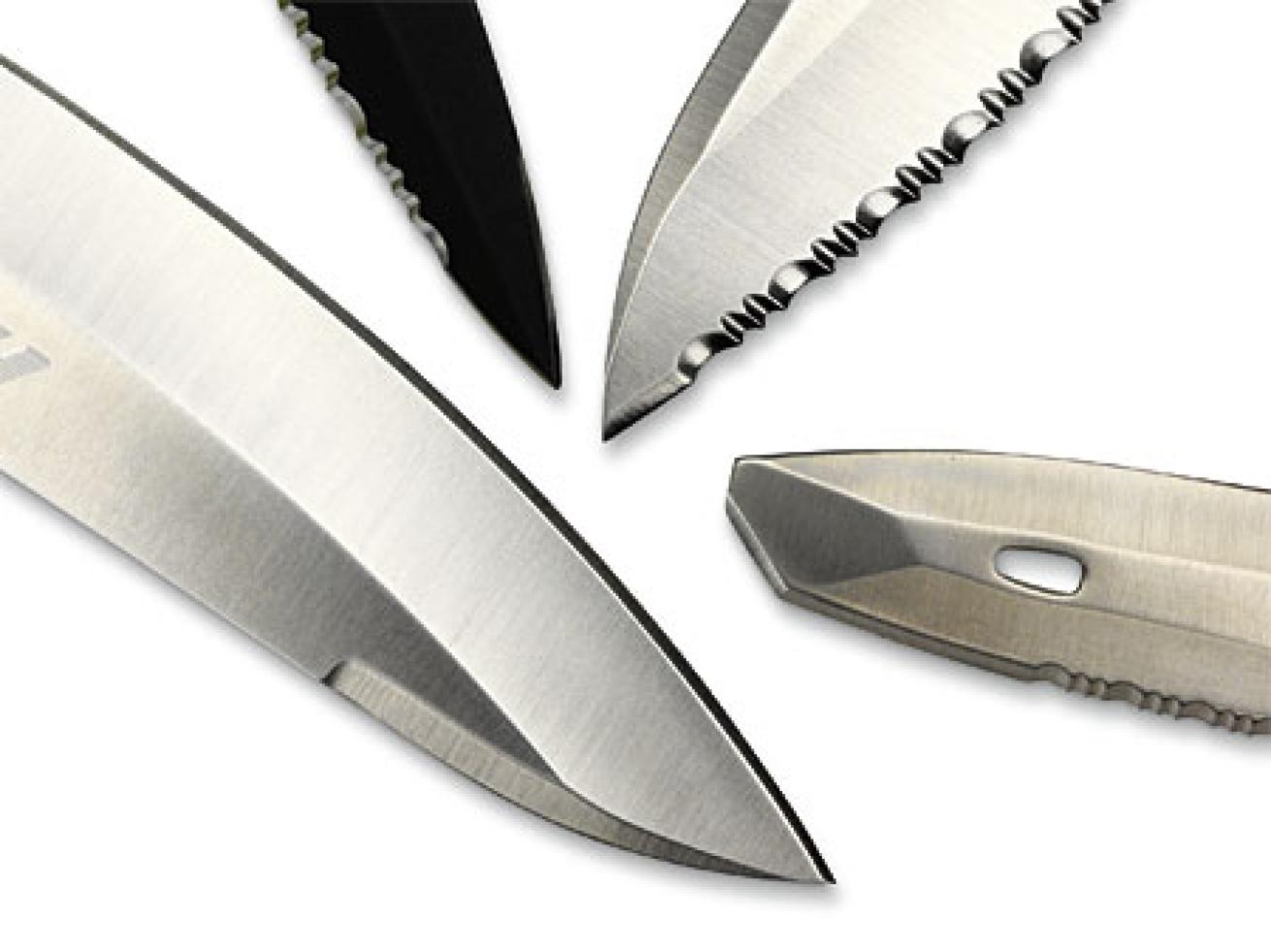
Scuba DivingDiving Knives
We know what you're thinking: sexy-looking diving knives are the perfect accessory to complete your underwater ensemble. But we were more interested in seeing how they performed on typical underwater cutting tasks. We turned these six knives loose on an assortment of materials commonly found in a marine environment, from fishing monofilament to three-strand anchor line to high-tech cable-strength braids. Since five of the six knives are full-sized, high-end cutters, it was no surprise that they were able to cut their way through our line inventory. What was surprising, given our experience with knife tests of the past, was how easily most of them did it. (See the individual reviews as well as "The Cutting Test".)
For this year's knife review, we tracked down six new models with designs or features that make them better-suited for particular styles of diving. All are serious cutting tools designed to saw and slice through diving's most serious cutting challenges. All of them are smaller than the massive dive knives of old, plus they're a lot more efficient at cutting and a lot easier to use, mount and maintain.
We also subjected them to our "rust test," an extended period of wet neglect in a saltwater environment to see how well they resist rust and corrosion. Each knife was soaked in saltwater three times a day for a week. Between soaks we set the knives out to dry while still in their sheaths. At the end of the cycle, knives and sheaths were inspected. In general, the titanium and more exotic stainless blades were the most resistant to corrosion, while the softer 304-grade stainless knives showed less signs of rust than the harder 420-grade stainless knives. No rust spots were so imbedded that they couldn't be buffed out with a towel. The lesson: A bit of maintenance will keep a modern dive knife looking new for virtually its entire operating life. (More rust test results can be found in individual reviews.)
Riffe Silencer
||| |---|---|
|<
table>
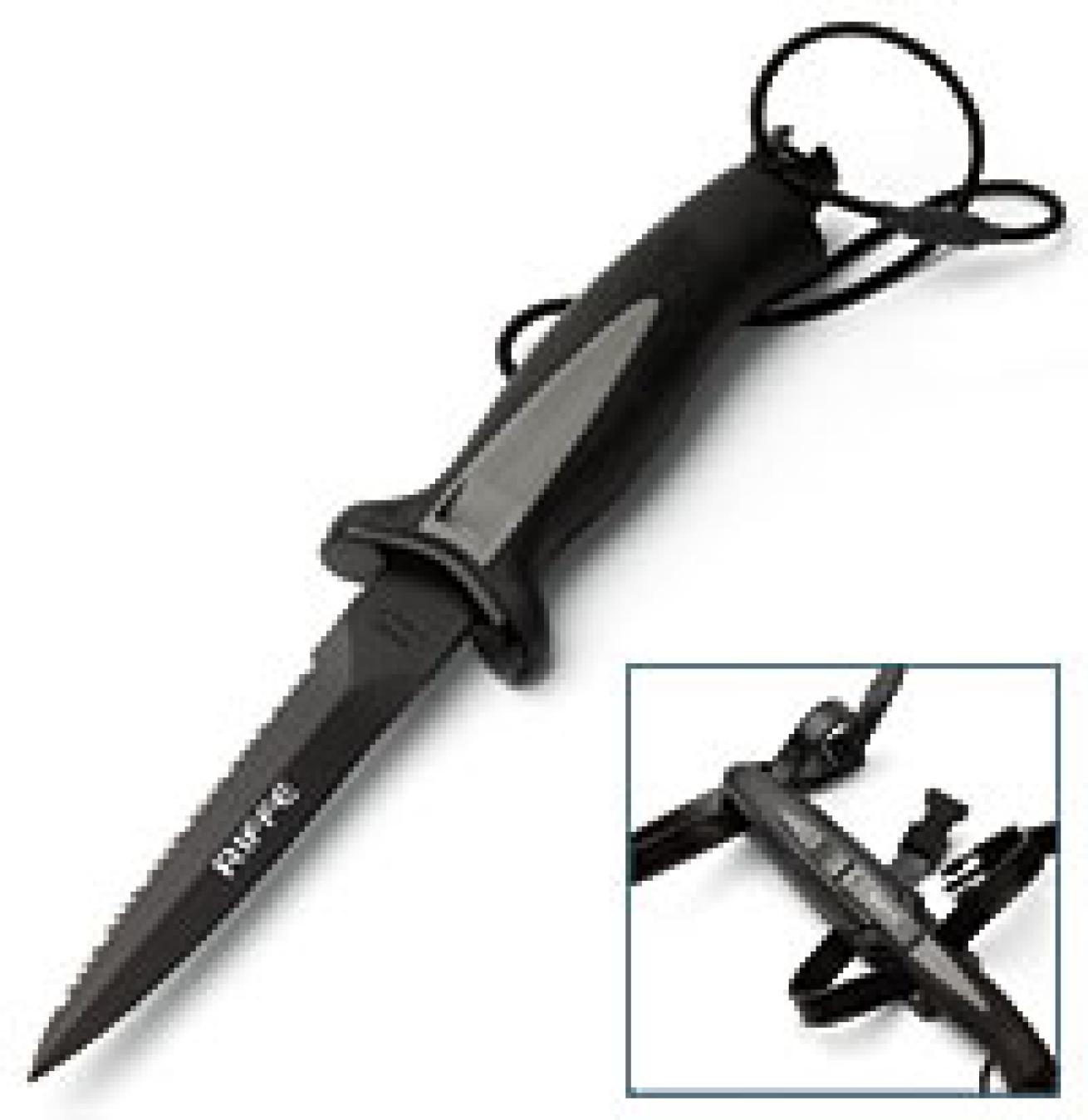
SCDRiffe Silencer
|
Overall length: 9 in.
Blade length: 4.5 in.
Blade type: Plain edge and serrated edge.
Material: 420 stainless steel.
Price: $90.
Features The Silencer is made of hardened (heat-treated) 420 stainless steel and has cutting edges sharp enough to cut virtually anything. The 4.5-inch stiletto blade, which is Teflon-coated to prevent rusting, offers a plain edge on one side and a wavy serrated edge on the other, giving you a choice of cutting surfaces. The over-molded handle has an ample blade guard for a safe and secure grip. It also offers a tool built into the end-cap to remove spear shafts that get wedged in rocks. The sheath comes with a pair of rubber leg straps and offers a locking push-button release. An elastic lanyard attaches to the end-cap for extra security.
Performance The Silencer's blade, with three inches of serrated edge and four inches of plain edge, proved to be the best all-around cutter in this review. It was the only knife able to slice through every type of test line--even the Amsteel--with a single pull, and it did it with both edges. For spearfishermen who can get wrapped in their own line during a hunt, this is the Silencer's strongest selling point. But the sharp stiletto point is a winner too, designed to quickly dispatch a struggling fish. While the blade is Teflon-coated to prevent rusting, the cutting edges aren't, so by the end of our corrosion test, the Silencer was showing a couple spots of rust; however, they all rubbed out with a towel. The Silencer's sheath is one of the best we've seen. A sliding safety mechanism prevents an accidental push of the push-button release. The safety and release button are both easy to operate one-handed, and the elastic lanyard can be stretched over the sheath for added security. Standard rubber leg straps have quick-release buckles and can be replaced with optional forearm stretch-straps for a closer reach.
Bottom Line A speared fish isn't always a dead fish, and the line you're caught in might be your own. For this, the Silencer is a must-have cutting tool. However, take care returning this sharp-point knife to its sheath, and a post-dive rinse is always recommended.
Best For Spearfishermen, dispatching fish or escaping a tangle of speargun line. Able to cut just about anything.
Scubapro White Tip
||| |---|---|
|<
table>
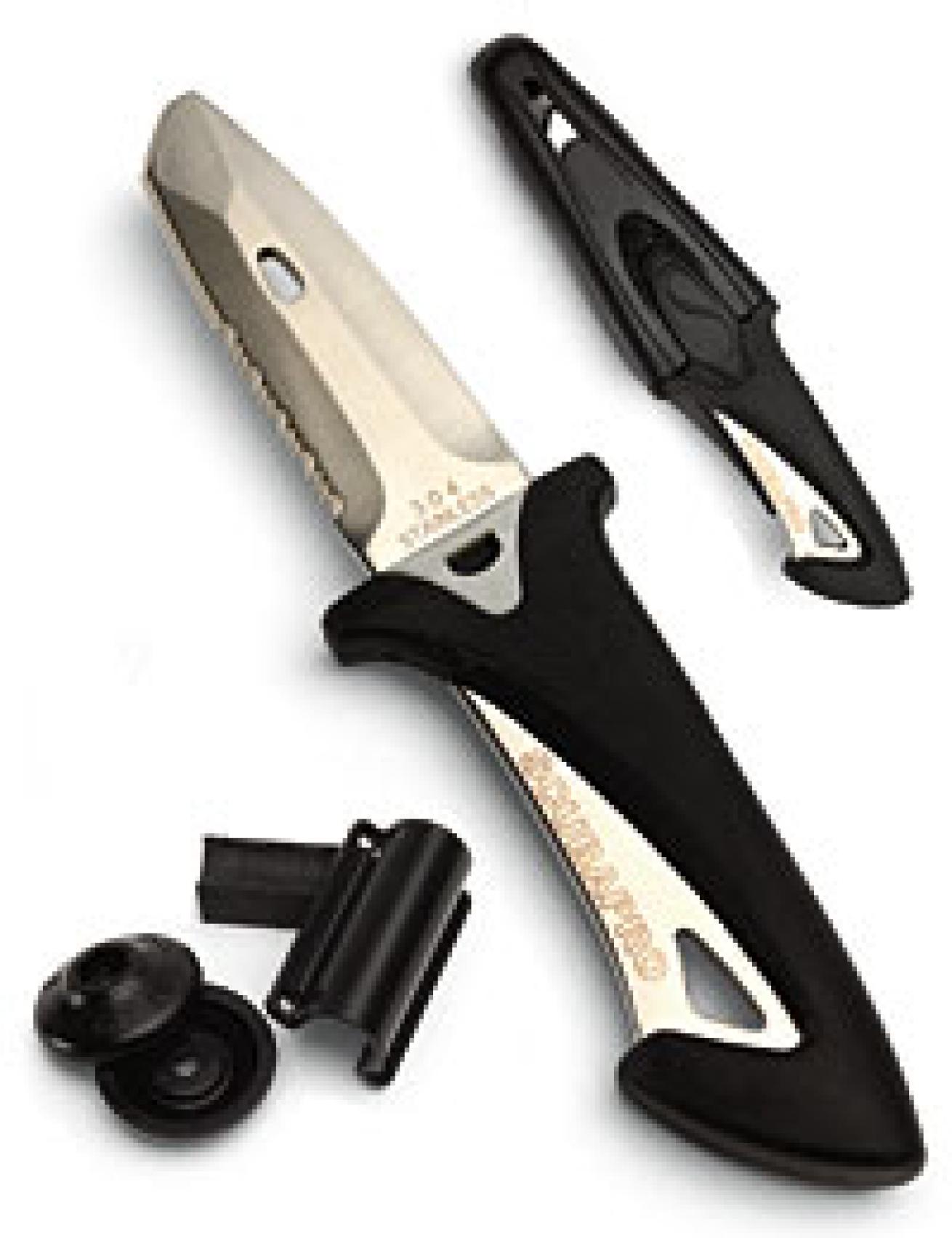
SCDScubapro White Tip
|
Overall length: 6 in.
Blade length: 2.5 in.
Blade type: Plain edge and serrated edge.
Material: 304 stainless steel.
Price: $58.
Features A backup cutter should be compact, and the White Tip is certainly that. Only six inches long overall, it comes with a 2.5-inch blade offering an inch of serrated edge, an inch of plain edge, and an angled tanto tip that's nicely blunted right at the end. The blade and handle are made from a single length of 304-grade hard-tempered stainless-steel--the handle portion is over-molded to provide an easy grip. The sheath offers a push-button release that keeps the knife secure until needed. The White Tip comes in a kit complete with hardware to mount on a console hose or BC pocket (this requires punching holes in the material). The sheath also has slots for threading a pair of rubber straps for mounting on an arm or leg. For added security, there's a hole in the handle for a lanyard.
Performance The White Tip offers more mounting options than any other knife in this review, making life easy when deciding where to strap it. Removing the knife from its sheath is also easy--the push-button release can be activated with one hand. The partially blunted tanto tip takes some of the apprehension out of returning the knife to its sheath, and a solid-sounding click lets you know the knife is locked in place. Because of its 304 stainless blade, which doesn't hold an edge as well as harder metals, and its short blade length that offers less cut per pull, the White Tip was not the most efficient cutter of the group. However, it was able to eventually cut through our entire inventory of test lines, taking only a couple pulls to get through the lighter lines, 10 to 18 pulls on the heavier lines, and 25 pulls on the Amsteel. It did a good job of resisting rust; after a week of repeated saltwater dunks it showed no signs of tarnishing.
Bottom Line It always makes sense to carry a backup cutting tool, especially one that's compact and doesn't clutter up a dive rig. We like the White Tip's ability to bolt to a hose, a strap or a BC. But if none of these options suits you, the White Tip is so small it will probably fit into your BC pocket.
Best For Just about anybody as a compact, BC-mounted backup cutter.
Spyderco Aqua Salt
||| |---|---|
|<
table>
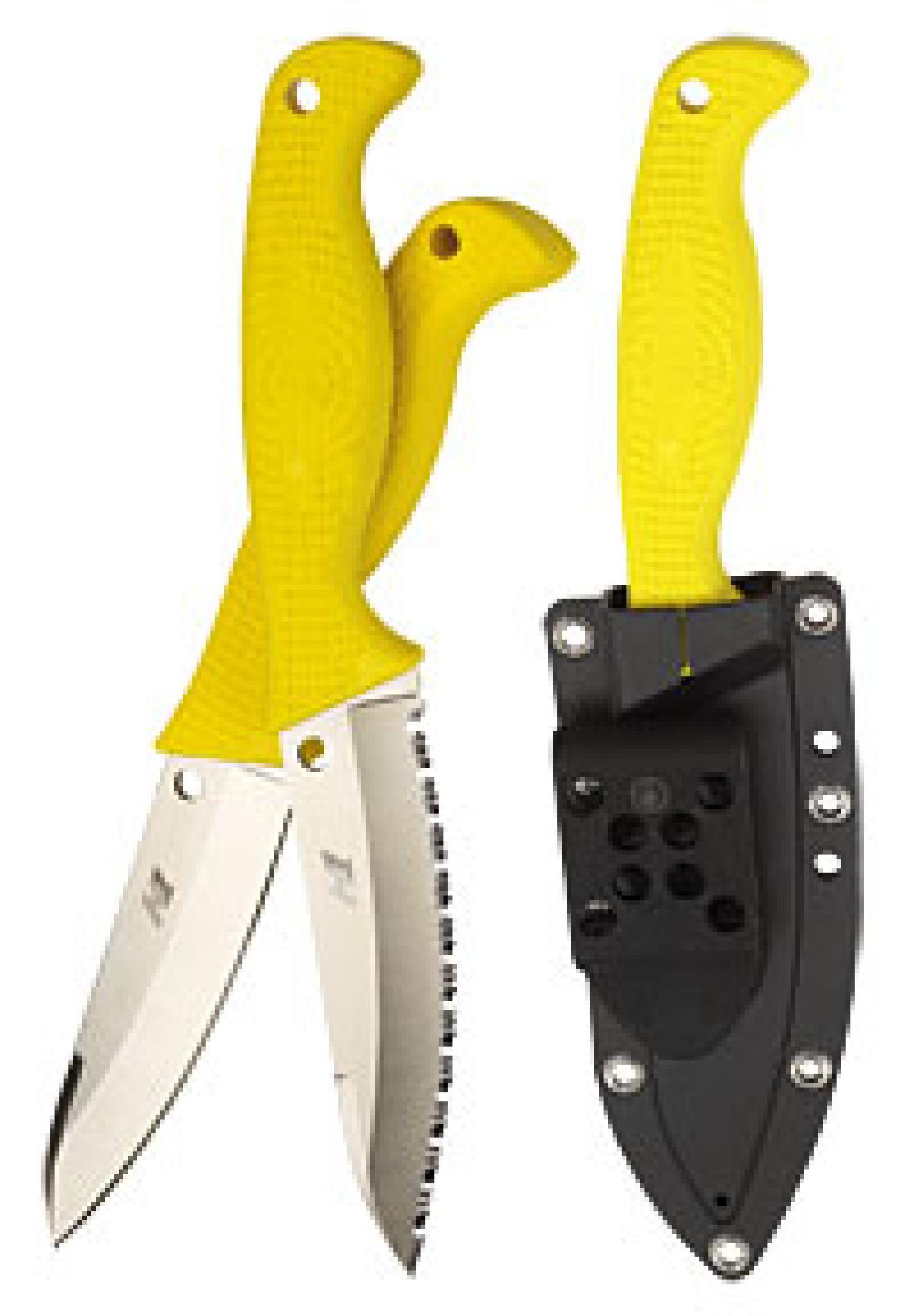
SCDSpyderco Aqua Salt
|
Overall length: 9.25 in.
Blade length: 4.5 in.
Blade type: All plain edge or all serrated edge.
Material: H-1 stainless steel.
Price: $164.95.
Features This knife is not to be trifled with. Its blade has a lethal point and comes with either a scalpel-sharp plain edge or a seriously serrated SpyderEdge (a pattern of one large and two small serrations) backed by a full-curve "belly" that produces very effective slicing-type cuts. The blade is made of rust-free H-1 stainless, a special composite exclusive to Spyderco that uses nitrogen in place of carbon in its steel matrix. This maximizes corrosion resistance while still enabling the blade to hold a sharp edge. The handle is made of textured, fiberglass-reinforced nylon. The heavy-duty Kydex sheath is riveted for strength. It secures the knife with a friction lock and features a G-Clip belt fastener that can be configured in five positions to suit your diving style. The Aqua Salt is available with either a yellow or black handle with a hole for a lanyard.
Performance Both plain edge and SpyderEdge versions of the Aqua Salt were able to cut through our inventory of line, though the serrated version had an easier time doing it. The full-sized handle let us grip and rip; while there's not much of a blade guard, the textured handle and finger grooves keep hands from slipping forward. We cut all test line with a single pull except for the Amsteel, which took five pulls. The H-1 blade excelled in the rust test, showing no signs of corrosion on the blade and only a slight bit of tarnish on the engraved "H1" logo, which rubbed right off. The G-Clip belt fastener fits securely on a standard two-inch harness strap, and the sheath's grommet holes offer cable-tie attachment points for added security. One-handed removal is accomplished by pressing your thumb against the top of the sheath. The large mouth makes an easy target when returning the blade home, which clicks when the friction lock activates.
Bottom Line If you've always had a hankering to take your sharpest chef's knife diving with you, leave it in the drawer and take this one instead. Of the two styles, we prefer the serrated version for its better cutting efficiency. But neither style disappoints. A bit of advice: Mount the sheath where you can see it; a near-miss when returning the blade home can get bloody.
Best For Working divers faced with heavy-duty cutting of all kinds.
Spyderco Mariner Salt
||| |---|---|
|<
table>
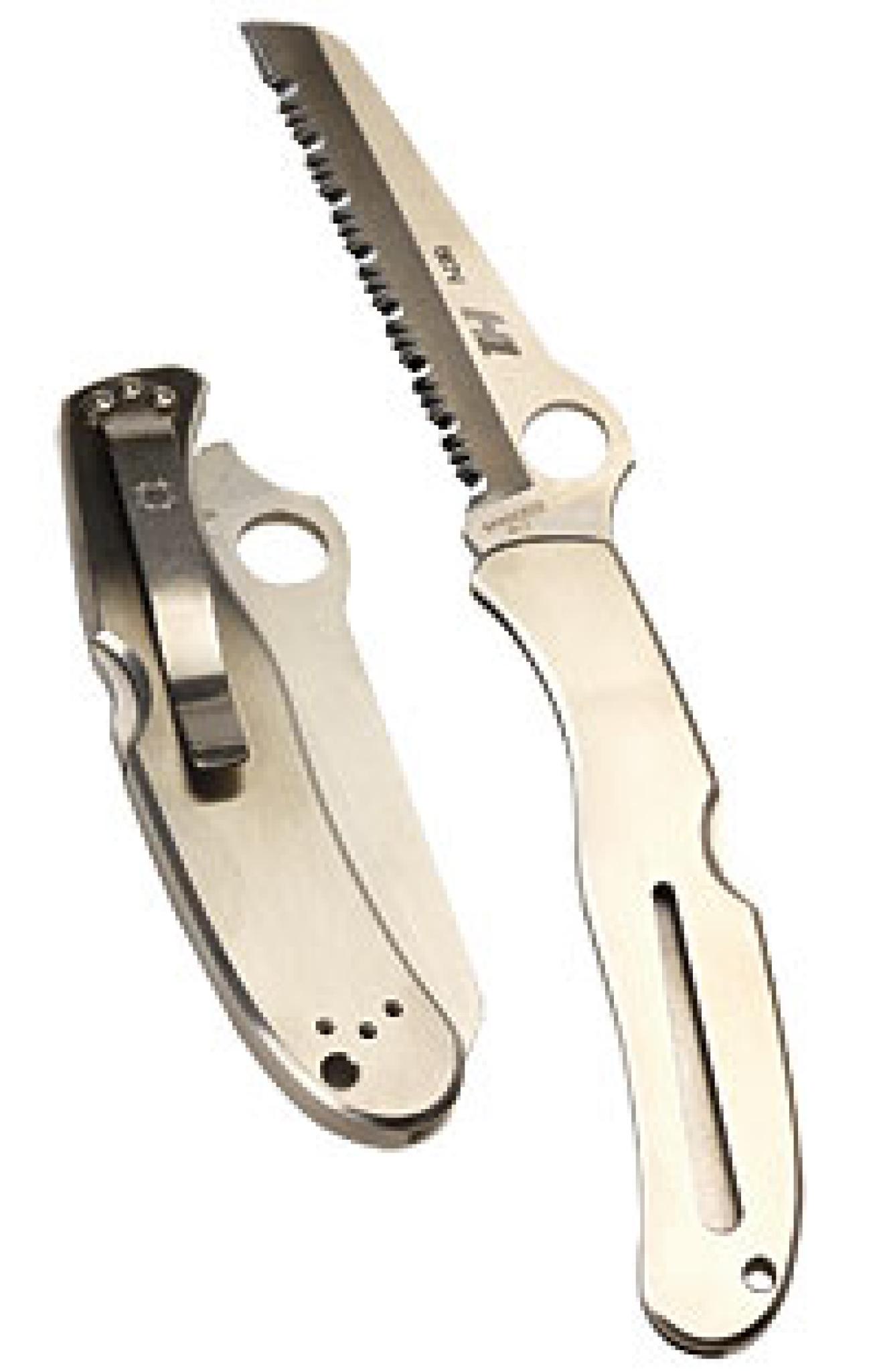
SCDSpyderco Mariner Salt
|
Overall length: 8.5 in.
Blade length: 3.75 in.
Blade type: Serrated edge.
Material: H-1 stainless steel.
Price: $209.95.
Features This all-stainless-steel folding knife is built specifically for saltwater environments, but can be used virtually anywhere. Like the Aqua Salt, the Mariner Salt's SpyderEdge blade is made of H-1 stainless, a special composite that substitutes nitrogen for carbon in its steel matrix. As a cutting tool, it offers a nice, simple design. A very usable sheepfoot-style serrated blade folds into a heavy-duty handle fitted with a shackle key, belt clip and lanyard hole, and that's it. Folded, the knife measures a compact 4.75 inches; open, 8.25 inches. The sheepfoot blade has a rounded tip for avoiding accidental pokes and punctures.
Performance The upside to this knife is its compact size when folded, and its full-size blade for cutting. Opening and closing the blade is a one-handed affair, thanks to Spyderco's Round Hole design. Just press your thumb into the hole in the blade and rotate it open. To close, press the indent on the back of the handle to unlock the blade and fold it closed. When it comes to cutting, the Mariner Salt knows its business. It sliced through all our test lines like proverbial butter--except for the Amsteel line, which required six pulls to get through. This was primarily because the sharpened points of the SpyderEdge serrations started to snag when the Amsteel became a tangle of frayed threads. Jimping, or texturing, on top of the blade improves thumb traction and makes it easier to apply cutting pressure. When it comes to maintaining this knife, fuhgeddaboutit. After a week of repeated dunkings in saltwater without a rinse, the Mariner Salt looked as good as new.
Bottom Line No doubt, this is the ultimate folding knife for a saltwater environment. Tip: Although it has a nice stainless belt clip, we found the best place to carry this knife when diving was in a BC pocket or small pouch fixed to a harness. And we'd also recommend attaching a lanyard. This cutter costs too much to lose.
Best For Traveling divers, and for all-purpose topside cutting. It's a full-size knife you can stow in your back pocket or BC pocket.
XS Scuba Beta Titanium
||| |---|---|
|<
table>
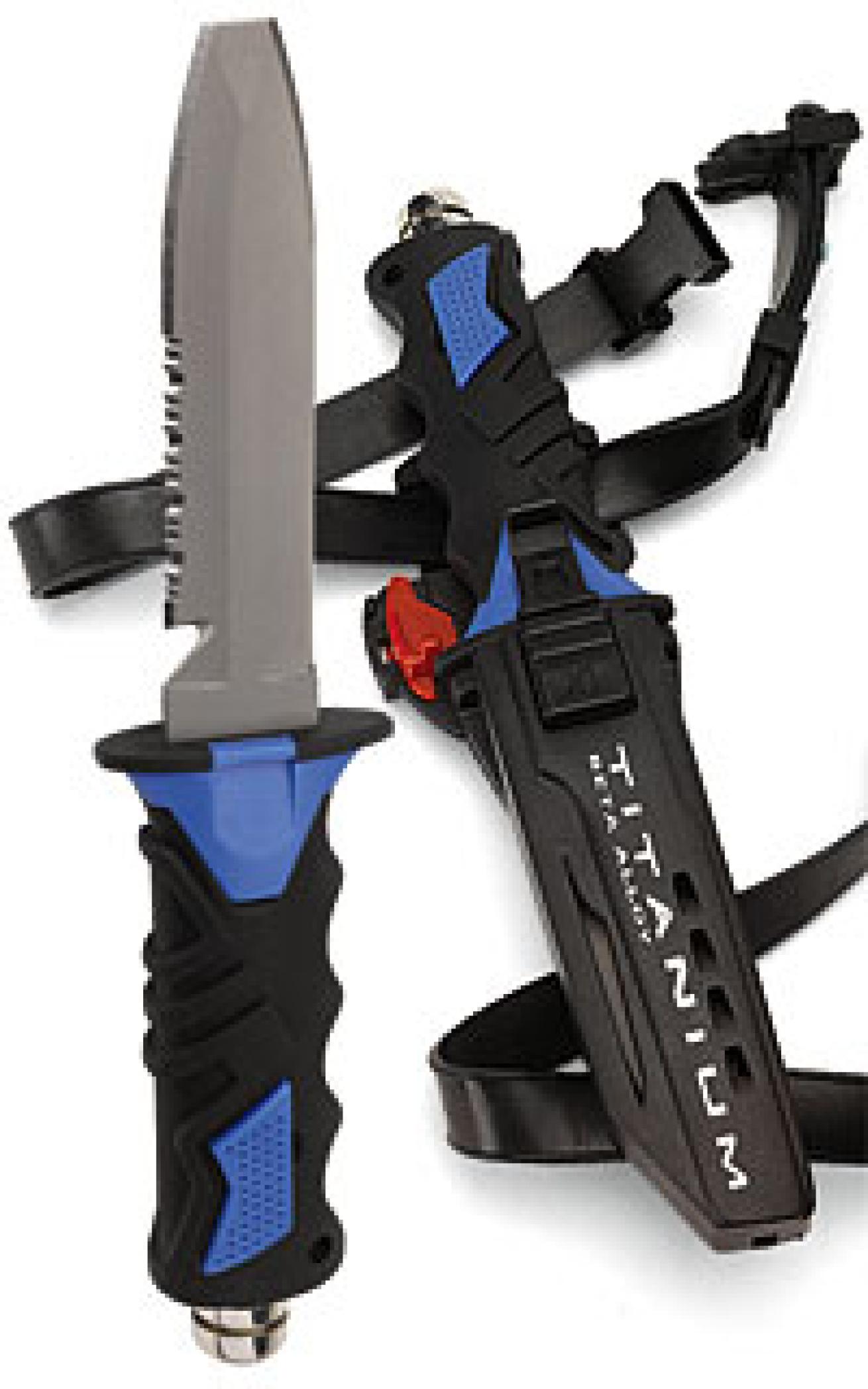
SCDXS Scuba Beta Titanium
|
Overall length: 10 in.
Blade length: 5 in.
Blade type: 1/2 plain edge, 1/2 serrated edge.
Material: Titanium.
Price: $110.
Features By today's standards, the 10-inch-long Beta Titanium can be considered a full-size dive knife, and it's a far sight better than the bruisers of the past. The Beta's blade is lighter, stronger and sharper than those of the Sea Hunt generation, and it's titanium, so it will never rust. The knife comes with a nice-sized Sure-Grip handle with moderate-sized blade guards, a stainless-steel end-cap for hammering, a combination plain/serrated cutting edge, a line-cutting notch, and your choice of a point, blunt or tanto tip. The sheath has a locking tab and a backup safety slide. Rubber straps with quick-release buckles are provided for attaching the knife to your leg.
Performance You can't beat titanium when it comes to rust resistance. At the end of our week-long saltwater dip tests, our Beta knife looked like it had just slipped out of its display box. XS Scuba sent us the tanto-tip version that offers a combination of plain and serrated edges on the main portion of the blade, plus a stretch of plain edge on the tanto tip. However, we found the serrated section to be the most effective cutting surface. The shallow serrations cut through all types of test line, including the Amsteel, with only one or two pulls. The Beta's handle fits very comfortably in the hand, with rubber over-molding and lower finger grooves for maintaining a secure grip. The sheath is first-rate and easy to access one-handed. Slide one finger under the primary release tab and the knife slips out. The knife reinserts with a distinct clicking sound. The backup safety slides over the blade guard to prevent dropouts, making this the one of the most secure sheath systems in this review.
Bottom Line This is a sizeable knife, reminiscent of old-school-styles, but much, much better. With the hammer end-cap, line-cutting notch and variety of cutting edges, the Beta Titanium is a true multipurpose tool. Get the blunt-tip version and you can do some light prying too.
Best For General-purpose cutting (all versions) and light prying (blunt tip only). This is a modern version of the traditional dive knife.
XS Scuba FogCutter Delta
||| |---|---|
|<
table>
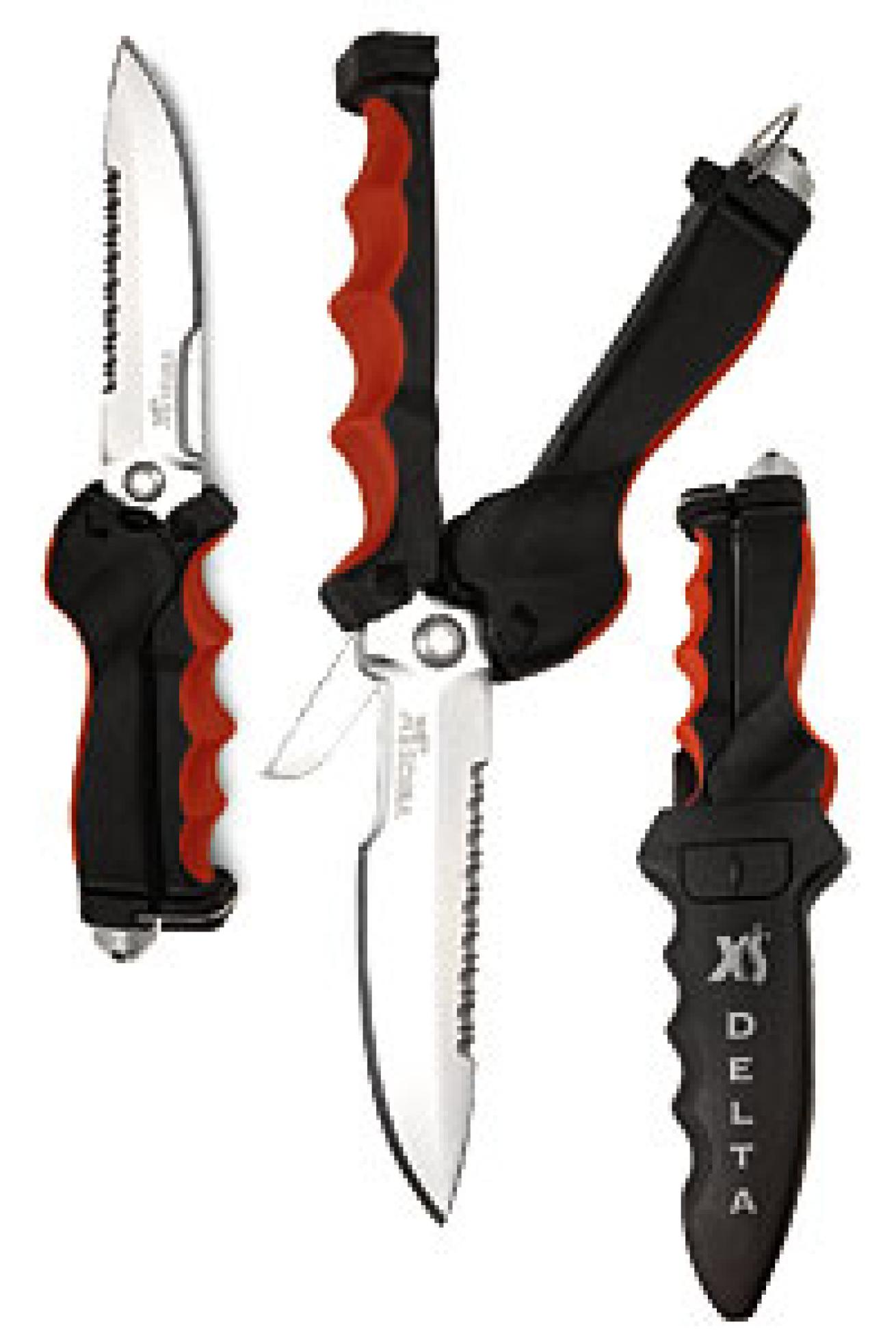
SCDXS Scuba FogCutter Delta
|
Overall length: 10.25 in.
Blade length: 4.5 in.
Blade type: Plain edge, serrated edge and shears.
Material: 420 stainless steel.
Price: $80.
Features The Delta is the largest cutter in this review and the most unique. It's the third generation in a line of FogCutter multipurpose knife/shears combo tools, and by far the best. The scissor blade is shorter than previous versions and located on the bottom side of the main blade. This greatly improves the scissor function while maximizing the knife's cutting surfaces, which include three inches of plain edge, close to two inches of serration on the lower edge of the scissor blade, and a 2.5-inch stretch of serration on the top edge of the main blade. The knife is made of 420-grade stainless steel to hold a sharp edge, and is treated with chromate to prevent rusting. A new co-molded handle with finger grooves provides a solid grip. It has an end-cap for pounding hard surfaces and will accommodate a lanyard. The sheath also has finger grooves, plus a knife lock with push-button release.
Performance The FogCutter Delta is a versatile tool offering all kinds of cutting choices. The shears worked better than most of the knives when cutting the thinner test lines. They bogged down on the 1/2-inch nylon and Amsteel, so that's when we switched to the knife blade. With serrated edges on top and bottom you can either press down or pull up when cutting through the thicker and tougher lines--it took only three pulls for the heavy 1/2-inch anchor line, two pulls for the Amsteel, and a single pull for everything else. The 420 stainless provides a nice hard edge, but after a week of saltwater soaks, it showed signs of corrosion where the blade contacts the sheath. However, we were able to scrub it all off with a towel. A nice surprise was that the hardware that holds the shears blades together showed no rust. As the longest knife in the group, the Delta fits best on the calf. The leg straps have quick-release buckles for easy donning and doffing, and the large release button on the sheath allows for one-handed removal.
Bottom Line The FogCutter Delta appeals to the MacGyver in all of us. It's a much more efficient cutter and easier to use than its predecessors. If you're a wreck diver who normally carries shears as a backup, the FogCutter Delta will make your day.
Best For Wreck divers who need good cutting blades plus some backup shears.
Zeagle Line Cutter
||| |---|---|
|<
table>
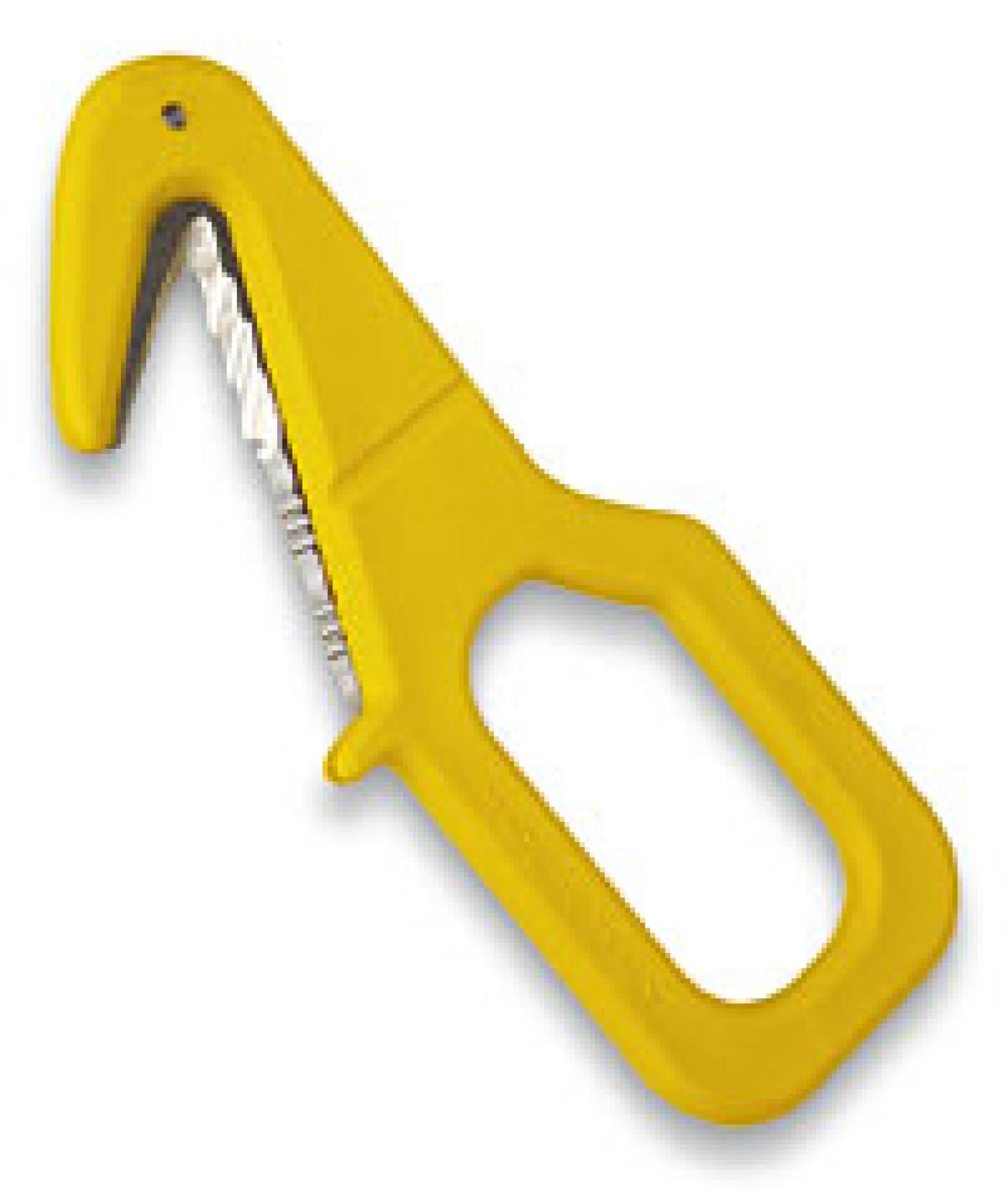
SCDZeagle Line Cutter
|
Overall length: 5 in.
Blade length: 1.75 in.
Blade type: Serrated edge and plain edge.
Material: Stainless steel.
Price: $19.99.
Features While not a dive knife, a line cutter can be an excellent cutting tool. Zeagle's line cutter is a perfect foil for anything from monofilament line to moderate-sized cord. It's compact, measuring only five inches overall, and features a large serrated edge with a variety of tooth sizes, and a handy yellow handle with room for a couple gloved fingers to grab hold. The friction lock sheath has a two-inch belt clip for quick mounting on most straps, or it can be cable tied almost anywhere on your dive rig.
Performance We were surprised that this line cutter was able to make it through every one of our test lines. Even the Amsteel parted after only six pulls. Not bad considering the cutter has such a short blade. Its compact size makes it a nice backup cutter to a traditional knife. The belt clip fits horizontally or vertically on shoulder and waist straps. However, the friction lock is minimal, so make sure to push the cutter into the sheath all the way before heading out on your dive. After a week without a rinse only a few spots of rust showed up and were easily scrubbed off with a towel.
Bottom Line Small, sharp and inexpensive, this is a practical tool for loop-type cutting and a great backup to a larger, more traditional primary dive knife.
Best For Cave divers, as a backup cutter for small line cutting.
Anatomy of a Dive Knife
What to look for in an underwater cutter.
Blade Material Stainless steel is the standard alloy for dive knives. Two particular grades get most of the business. Traditional 304-grade stainless is relatively soft as far as metals go. As a result, it doesn't hold an edge as well as harder metals, but it excels in resisting corrosion. There's also 420-grade stainless, which is harder so can take and hold a sharp edge, but is more susceptible to rust. For a touch of the exotic, Spyderco offers its H-1 stainless steel. This is a special composite that uses nitrogen in place of carbon in its steel matrix. Substituting nitrogen for carbon makes steel harder--so it holds an edge better--but because nitrogen doesn't react with chloride like carbon does, rust never gets the chance to grab hold. And then there's titanium, which resists rust completely, holds a sharp edge and is much lighter than stainless steel.
Cutting Edges Serrated edges are great for sawing through rope, while plain edges are best for making clean slicing cuts. All knives in this review except the Mariner Salt either have blades with a combination of plain and serrated edges, or they're available in either full plain or full serrated styles. The Mariner Salt is available with a serrated blade only. Knives offering both edges on the same blade make good all-around cutting tools, but loading more than one cutting surface on one blade edge forces each cutting surface to be shorter in length, which can impact cutting efficiency.
Serrated edges can be either repetitively deep and pointy or shallow and wavy in their design. Tests show that the shallow, wavy serrations have plenty of bite, but won't snag like the more pointy serration.
Some blades offer line-cutting notches, which are fine, but don't worry if the knife you want doesn't have one. The closely spaced grooves of a serrated edge perform the same function.
In general, the longer the cutting edge, the more efficient the knife. Some knives that offer both serrated and plain edges take advantage of both upper and lower edges of the blade to maximize the length of each cutting edge. None do this better than the Riffe Silencer, which devotes the entire top edge of the blade to serration and the entire bottom to a plain edge, and it's the best cutter of the group. Types of Tips Dive knives usually come with one of three types of tips: Blunt, Pointed and Tanto, named after the Japanese knife.
A Blunt tip is a bit safer for diver and gear as it is less likely to puncture when being waved around or returned to its sheath. This is a good choice if you're planning on mounting your knife on your BC pocket. Blunt tip knives also can be used for light prying.
A Pointed tip, either drop-point (like on a bowie knife) or stiletto (narrow, with symmetrical sides, both of which have a sharpened edge), is great when you want to get a cut started when tackling a tightly bound line.
A Tanto tip is a hybrid of blunt and pointed, with an angled tip that's sharpened for cutting and possibly capable of light prying, often with a spot of bluntness on the very tip. This can be a good compromise on a general-purpose knife. Handles Much of a knife's cutting ability comes from the leverage and pressure brought to bear through the handle. Knives with smaller blades can still cut well if the handle is large enough to give good control. Handles with finger grooves and blade guards keep the knife from slipping.
Sheaths A good sheath not only keeps the knife secure, it offers multiple mounting options. Most sheaths on large knives come with standard leg straps. Some have a two-inch belt clip or loop for harness or strap mounting. Smaller knives, like the versatile Scubapro White Tip, come with hardware for mounting on a BC or hose. Most modern sheaths use mechanical or friction locks to keep knives from falling out during a dive. The best sheaths allow you to remove and replace the knife one-handed.
Folding Knives The benefits are obvious: When folded they're small enough to be easily stowed in a BC pocket, but open them up and you get the benefits of a full-sized cutter.
The Cutting Test
|| |---|
|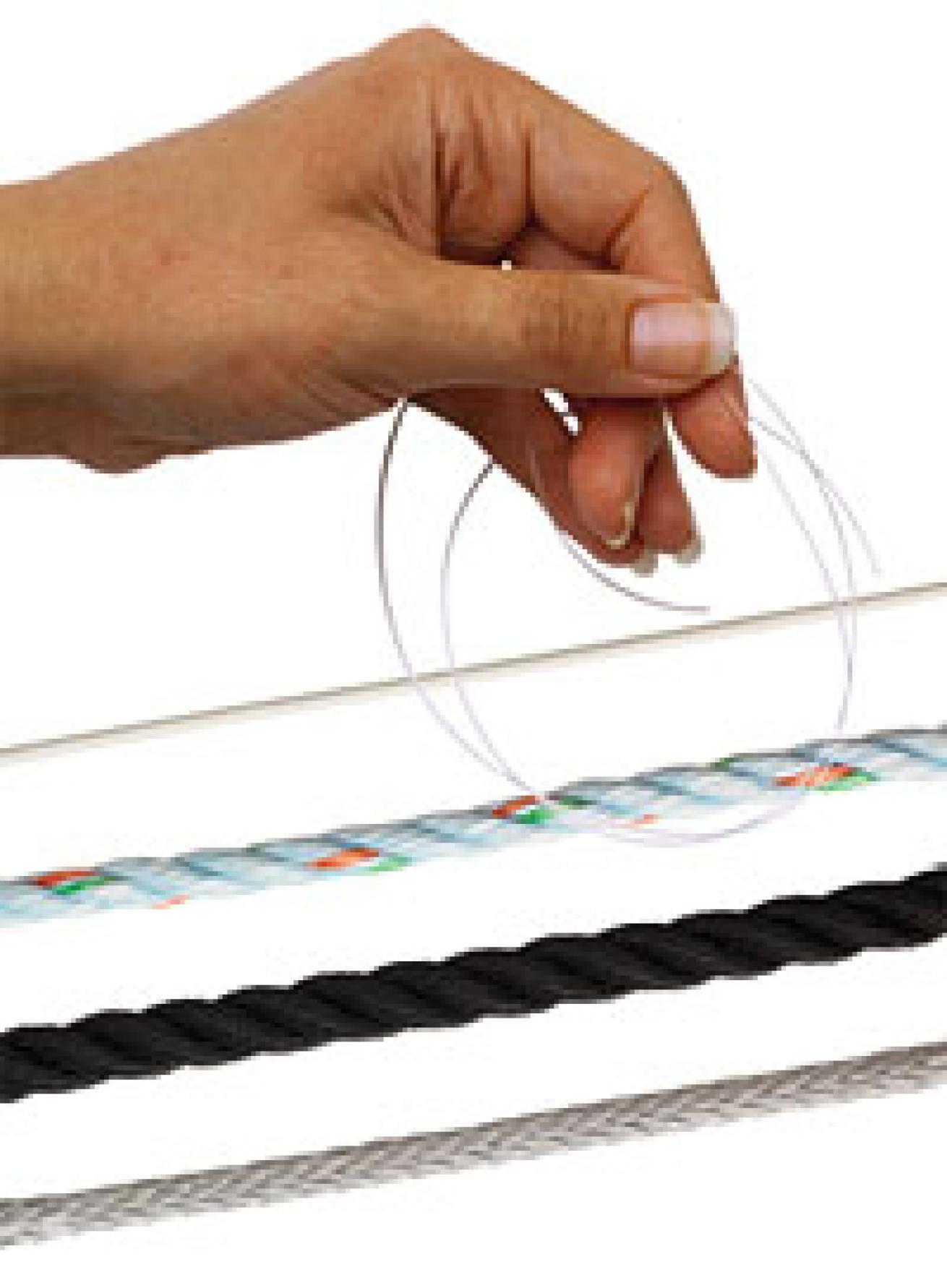
SCDKnife citting test
|
We tested each knife on a variety of materials common to a marine environment:
30-pound monofilament fishing line
1/8-inch general-purpose Dacron braid
3/8-inch polypropylene line commonly used on lobster pots and other fishing traps
1/2-inch three-strand nylon anchor line
1/4-inch Amsteel, a tough-as-nails 12-strand, single-braid line with Dyneema core that's used as a substitute for wire rigging We used two cutting methods on each material:
The Loop Method After forming a loop with the line, we held the base of the loop in one hand, while with the other we took the knife blade and sliced at the loop using an upward cutting motion. We found this to be the most efficient cutting technique because it lets you use the full length of the blade.
The Sawing Method A length of line was stretched over a wooden block and then a sawing action was used to cut the line. This method simulated a situation where you can't get the knife blade underneath the line to perform a loop cut, like a line wrapped tightly around a boat's propeller shaft.
General findings
All of the knives here were able to cut through our test materials, but some took longer than others depending on the blade material, edge used and the cutting technique applied. Specifically:
The loop method of cutting is by far the more efficient cutting method with all knives. Tests show that, in general, it takes twice as many saw method slices to get through a stubborn line than it takes pulls using the loop method. We recommend using the saw method when it's your only option, like when trying to free a wrapped prop.
Better cutting results can consistently be achieved using a serrated edge rather than a plain edge. Most of the serrated edges we tested took only one or two pulls to cut through the test materials--the exception being the Amsteel line.
The XS Scuba Beta and FogCutter Delta were able to cut through the super tough Amsteel with only two pulls of their serrated edges. The Spyderco Aqua Salt took five pulls, the Spyderco Mariner, six pulls, and the Scubapro White Tip, 25 pulls.
The Riffe Silencer was the only knife capable of slicing through every type of test line, including the Amsteel, with only one cut.
Care & Maintenance
While dive knives can generally withstand a few days of post-dive neglect, as evidenced by this year's rust test, they will eventually show signs of corrosion if left caked with salt in a damp dive bag until your next trip. BC knives and those that can be stowed in pockets are even easier to forget about. To keep them like new and ready to cut follow these simple tips:
Rinse the knife in freshwater after your dive with the blade removed from the sheath. If it's a folding knife, open and close it repeatedly to wash out any sand and salt. If the knife disassembles for cleaning that's even better.
Dry the knife and wipe off any spots of rust that may be developing. Even after a week of neglect we were able to remove light rust buildup with a towel. If it persists, try a toothbrush or thumbnail. It's also important to let the sheath dry before storage as we found rust spots often occur where the sheath comes in contact with the blade.
Spray the blade with a light coating of silicone to prevent rusting. Just a light sheen on the blade will do--too much will attract dirt. Do not use WD-40 or any other petroleum-based products as they may accidentally contaminate your scuba gear. Return the blade to the sheath and check the locking function and straps in case they need to be repaired or replaced before your next dive.

